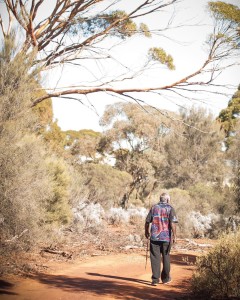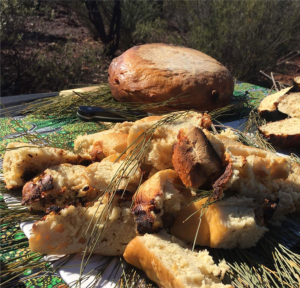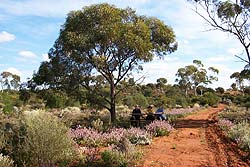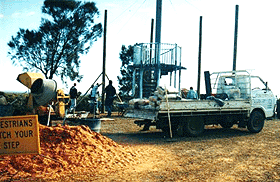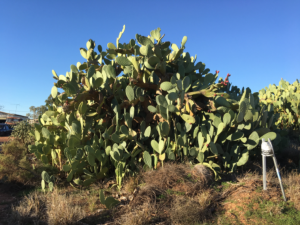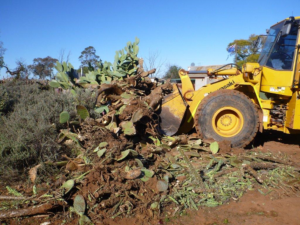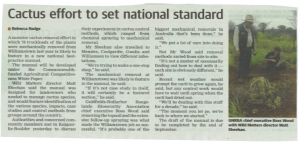Current Projects
ABOUT THE PARK
Karlkurla (pronounced gull-gurl-la) Bushland Park, located along Kalgoorlie’s northern edge and within 5km of the City’s CBD, comprises 200 hectares of natural regrowth bushland that showcases stunning examples of Great Western Woodlands vegetation. Representing a snapshot of the ‘natural’ regrowth Goldfields bushland and Eucalypt woodland, the bushland park comprises iconic native flora including salmon gums, melaleuca trees, sandalwood and silky pear vines, also referred to as ‘karlkurla’ (pronounced gull-gurl-la) by the local Aboriginal population.
Karlkurla Bushland Park has an interesting history of land use, including prospecting, pastoral and timber harvesting, and more recently as a Regeneration Zone. The bushland park is one of six regeneration zones that were established in the early 1970’s by the Goldfields Dust Abatement Committee, which KBULG replaced in 1994.
To accelerate the regeneration of the native bushland, KBULG implemented an ecological restoration project from 1999 to 2002, supported by the late councillor and work for the dole supervisor Doug Krepp and program participants. The project also successfully bestowed the bushland park with a range of educational and recreational infrastructure assets including Katunga Lookout, the Doug Krepp boardwalk and interpretive signage
FACILITIES
A picnic table is located every 200m along the walk trail and interpretive signage is placed at points of interest. There is a shelter near the main entrance with picnic tables and a long drop toilet.
A brand-new (completed in July 2024) all-inclusive nature playground, one of WA’s largest regional playgrounds, provides a great spot to play & relax in a beautiful bushland setting close to the bushland’s park main entrance gate. Equipped with a lawn, gas barbecues, wheel-chair-friendly footpaths and a toilet block, the playground presents a perfect addition to a walking or biking adventure.
FAUNA
Karlkurla Bushland Park is home to many animals. If you are very quiet or visit the Park in the early morning or evening, you may see a western grey kangaroo or two.
There are also a number of reptiles found here. Bobtails are often seen in spring as the weather warms up. If you are lucky you may see a dragon lizard or even a mulga snake.
There are a varitety of birds in the Park. Magpies, willy wagtails, honeyeaters and miners are common.
FLORA
Several unique flora speciea are found in the park. Some of these species include: the Karlkurla (native pear), Eucalypts (gum trees), Eremophilas (emu bush), Acacia’s (wattles), Senne species (cassia), Saltbush, Bluebush and Sandalwood. Annual species include Everlasting Daisies, Mulla Mullas and the Twining Fringe Lily.
SELF – GUIDED BUSH WALK
Among the extensive 7km network of meandering walk and bike trails is the 4km Doug Krepp Walking trail that begins with a boardwalk, passes by Katunga Lookout – a panoramic tower platform with spectacular views, and includes interpretive signage on historical mining operations on this land and the many species of native vegetation found here today. The walk generally takes 1 – 2 hours and participants should wear sturdy covered shoes, sunscreen and a hat and carry water.
MORE WAYS TO ENJOY THE PARK
- Enjoy the sunset from the top of the Katunga lookout, located about 1.5km from the Park’s entrance
- Have a picnic in the park. Picnic tables are located every 200m along the walk trail. Please take your rubbish home with you.
- Visit the park in the early morning – listen to the bush waking up. There are many bird species in the park and various mammals including kangaroos, which are particularly active at daybreak.
- Take time out from the hustle and bustle of life. Relax, read, paint or take photos of plants, animals and landscapes of the park.
- Walk with a group of friends for exercise and fresh air.
- Play, meet and share a picnic/barbecue at the brand-new all-inclusive Nature Playground while relaxing in a beautiful bushland setting.
NATIVE PLANT GUIDE
A comprehensive Native Plant Guide of the Park can be purchased from the KBULG Office and the Kalgoorlie-Boulder Visitor Centre.
This book has been developed to provide an appreciation of the extraordinary bushland around Kalgoorlie-Boulder, and in particular, the plant species found in Karlkurla Bushland Park. The book includes a range of Kalgoorlie-Boulder’s flowering shrubs, trees and everlastings.
BE AWARE
Visitors are encouraged to appreciate the plants in the bushland park by observing and photographing the plants. Please note: It is illegal to pick wildflowers or any native plant material in Western Australia without a special permit.
Please respect the animals and other Park users by keeping your dog on a lead at all times.
Caltrop Eradication
CALTROP
Spreading, Prostrate Plant that has small yellow flowers, & produces a burr with Spines.
Very common around Kalgoorlie-Boulder. Can be found in gardens, along the edges of Gribble Creek pathway & on verges.

People often confuse caltrop with Doublegee. Doublegee does not actually grow in Kalgoorlie-Boulder or the surrounding Goldfields. What people generally think is doublegee is in fact Caltrop.
Caltrop germinates after rain & high temperatures of more than 30 C. The weed takes only 3 weeks to flower after germination and 10 days later can produce fruits. Hence the rapid germination after our recent rainfall.
If conditions remain moist, it will continue to seed indefinitely, so it is important that the weeds are removed as soon as they come up.
- For small areas of the weed, they can be hand pulled using gloves and a small shovel and placed in a plastic bag in the bin.
- For larger infestations a herbicide may be used such as ‘Round Up’ but check with your local hardware store and read the safety instructions carefully.
We all need to make a special effort over the next few months to remove any plants we see in our yards, on road verges and around schools, parks etc.
The nasty prickles can puncture bike tyres and lodge in shoes and are a problem for adults, children and pets.
Control Methods
- Some research is being conducted into biological control agents.
Hand Pulling – good after rain or a watering.
- Gardening gloves are recommended if pulling weeds
- It is best if all leaves and stems are taken hold of to pull – ensure complete removal of the plant (weeds can grow back if not completely removed).
- If weeds snap off at the base of the plant a weeding fork or shovel might be more appropriate.
Complete Plant Removal – for removing roots, plant material and seeds.
- Use a Weeding fork or shovel to dig up the entire plant
- Ensure no seeds are left on the ground.
Chemical Control – good for young plants
- Only spray on a calm day and when there will be at least 6 hour of direct sunlight.
Never spray when rain is expected or when it is windy.
Always use protective clothing when spraying.
- Safety equipment includes gloves, a mask, longsleeve shirt & long pants, safety glasses, sunscreen & a hat.
Please read the safety instructions carefully before using any chemical sprays. Also be aware of what action to take if any skin contact, inhalation etc does occur.
‘Roundup’ or any glyphosate product is an effective spray to apply to weeds in the Goldfields and is available from most hardware stores & nurseries.
Disposal of Weeds
Do not put weeds or clippings containing weeds in a compost heap – they will only grow and spread.
- Dispose of weeds carefully in a green wheelie bin for kerbside rubbish pickup
- Alternatively secure & cover weeds carefully and transport to the tip. Securing weeds will ensure they do not fall off the vehicle/trailer on the way to the tip and infest road reserves.
NEVER DUMP WEEDS IN THE BUSH – weeds can easily invade natural bushland.
Re-infestation may occur – check the site regularly for weed germination and remove weeds as soon as they appear.
The control methods suggested above need to be repeated on a regular basis.
KBULG’S JUNIOR LANDCARE
Environmental education and awareness-raising of the younger generation is KBULG’s core objective, and the group actively engages with the City’s ten local primary schools and four secondary schools through the Junior Landcare Program (JLP). The long-term continuation of the Program is one of KBULG’s main priorities, and the organisation continuously works on evaluating current strategies to engage with the schools of the Goldfields, frequently interacting with schools to investigate opportunities for new collaborative environmental education projects. For almost 20 years, hundreds of students from all of Kalgoorlie-Boulder’s primary and secondary schools have learnt about the unique Goldfields environment and its conservation significance through educational bushwalks, tree planting events and classroom talks as part of KBULG’s Junior Landcare Program.
KBULG pro-actively invites all teaching staff from the City’s ten primary schools and four secondary schools to take advantage of having access to KBULG’s expertise and resources. KBULG welcomes all types of interest from schools in relation to projects conveying the environmental and cultural uniqueness of the Goldfields. The organisation works hard to accommodate any request from schools to deliver Junior Landcare activities according to the schools’ specific requirements. High-in-demand Junior Landcare activities are tailor-made educational bushwalks, tree planting events on school grounds, and classroom talks & activities. To keep schools updated and engaged in contemporary environmental issues and the group’s events and activities, KBULG provides schools with regular updates, information and reminders about its activities. Our organisation is grateful for the schools’ enthusiastic participation in KBULG’s major annual community events such as the rECOnstructed Art Competition, the Clean-up Kalgoorlie-Boulder Day and the Kalgoorlie-Boulder Tree Planting Day.

KBULG strongly promotes aboriginal involvement in Landcare and Cultural Education. The organisation successfully negotiated and commenced the implementation of a landscaping and rehabilitation project with the Wiluna Ranger Program in June 2017, while also intensifying its partnership with Wiluna Remote Community School. Given the unique conservation value and pronounced indigenous heritage of the region, KBULG is proud to contribute to facilitating indigenous involvement and ownership in conservation and land management on the ground. KBULG has also supplied native plants for restoration projects to the Tjuntjuntjara Aboriginal Community, and endeavours to further expand its engagement with Aboriginal communities.
With the assistance of a grant from the Boulder Rotary Club, KBULG has equipped the community nursery with aboriginal artefacts and tools for demonstrations during cultural tours and events at the community nursery. The organisation continues to engage local Aboriginals to actively take part in community initiatives, interacting with residents by providing them with employment opportunities as Aboriginal Guides for KBULG’s cultural tours, and encouraging them to their share their knowledge about Aboriginal practises and traditional uses of the land and plant species in the Park.
KBULG seeks to continuously expand its engagement with aboriginal youth who visit the nursery to partake in education and training courses, often accompanied by aboriginal elders.
A ‘green belt’ has been created around the perimeter of Kalgoorlie-Boulder by establishing a series of fenced Regeneration Zones that prevent stock grazing and vehicle access. These Regeneration Zones encompass an area of approximately 3,500 hectares. The
Regeneration Zones were established by KBULG’s predecessor, the Goldfields Dust Abatement Committee, as a way to combat the dust storms of the early 1970’s.
The Regeneration Zones (see Regeneration Zones pamphlet) are mostly remnant native bushland in close proximity to the City. KBULG encourages the community to use the zones for passive recreation. Many members of the community are keen to see these areas preserved as they enjoy their walks in the local bush close to their home. There is unique flora found in the zones including several different Eremophila species; some have very restricted distribution, for example Priority 1 species, Eremophila praecox.
However, trail bikes and stolen cars are a constant problem in the Regeneration Zones. Woodcutting and rubbish dumping are also major management issues that need to be addressed. Some of the Regeneration Zones may be taken up for urban development as the City expands. However, KBULG has been invited by the City of Kalgoorlie-Boulder to have a role in recommending which areas are of the highest conservation value and should be preserved. Students from Curtin University’s Environmental Technology class have also assisted KBULG by undertaking botanical surveys in the Regeneration Zones. KBULG regularly conducts audit of the Regeneration Zones, focussing on the integrity of the fencing and areas of rubbish dumping and weed infestation.
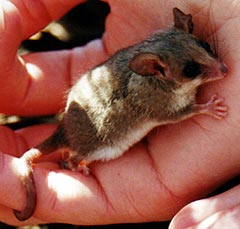
KBULG is dedicated to promote and encourage recycling in the City and includes ideas for recycling and re-use in our bi-annual newsletter, in addition to encouraging the community to support local businesses that recycle.
Several schools are involved in recycling activities in association with KBULG, including newspaper and aluminium can recycling.
A Waste Management Forum, co-ordinated by the City of Kalgoorlie-Boulder, is regularly organised with the purpose to investigate various recycling options. KBULG is a member of this group and brings particular emphasis on education and promotion for Junior Landcare students and general community involvement.

Scatter the Silky Pear
The Goldfields first ‘touched by nature’ Tourism Project is located in Karlkurla Bushland Park. It is part of a statewide nature based tourism initiative designed to help protect and enhance Western Australia’s unique natural environment.
Anyone can be involved with the regeneration of the ‘Silky Pear’ at Karlkurla Park by giving a gold coin donation and picking up a brochure with a packet of seeds from the Kalgoorlie-Boulder Tourist Centre in Hannan Street. Dispersal points for the ‘Silky Pear’ seeds are located along the walk trail in Karlkurla Park.
Proceeds from the project come back to KBULG to help maintain the park.
Work for the Dole
In order to achieve the goals, KBULG developed the 1st Work for the Dole Project in the Goldfields which commenced in March 1999. With funding from the City of Kalgoorlie-Boulder and the Department of Employment and Workplace Relations, Work for Dole participants have been involved in:
- Construction of an octagonal lookout with 360 degree views of the surrounding bushland
- Construction of a boardwalk
- Construction of a shed, shelter and work area
- Installation of a long drop toilet
- Installation of 20 jarrah picnic tables
- Establishment of community nursery to propagate local native plants with seed collected from within the park
- Cultivation of a vegetable garden
- Addition of plant identification labels with the plants scientific, common and aboriginal names for an approximate 50 different plants
- Installation of interpretive signage as part of KBULG’s Centenary of Federation project
- Laying of reticulation for an Olympic Landcare Project where 2000 trees and shrubs were planted in the park by 400 community members.
Educating the community about waterwise practices and sharing advice on gardening within an arid environment is very relevant in the Goldfields region due to Kalgoorlie-Boulder’s low average annual precipitation levels of approximately 280mm.
KBULG has been fortunate to frequently welcome visitors seeking information about local plants and sustainable, waterwise gardening with native plants in its open Community Nursery. Nursery staff happily provide advice and share practical knowhow on plant propagation and opportunities to create waterwise gardens with native plants.
Past Projects
Invasive Cacti represent a major biodiversity threat to the Goldfields. Williamstown, the remains of East Kalgoorlie, which now consists mostly of ‘The Super Pit’ open cut mine, was severely affected by species of cacti that have been declared pests in Western Australia. The small existing area features mostly housing with one small primary school. It is also home to the Mount Charlotte mine shaft and Nanny Goat Hill. Tenure issues were complex as the project site covered council land, unallocated crown land and is also part of a mining lease.
Coordinating the large-scale cactus eradication was complicated by multi-tenure issues and the overwhelming nature of the task, making it impossible for one individual agency to successfully tackle the issue.
Developing a best practise approach making effective use of the unique resources and skill sets from different agencies KBULG as the coordinating agency successfully mobilized and delegated the involvement of the community, the City of Kalgoorlie Boulder, Parks & Wildlife and KCGM.
Through a combined effort between these agencies and the Department of Primary Industries & Regional Development (DPIRD), the Goldfields Nullarbor Rangelands Biosecurity Association (GNRBA), Boulder Contracting and Maintenance, and coordinated by KBULG, a staggering 765 tonnes of declared high-priority invasive cacti species/waste was mechanically removed.
This commendable group effort has been acknowledged as a best practice role model solution for similar future situations by DPIRD and the Governor of Western Australia.
KBULG has produced a pamphlet on ‘Gardening with Local Native Plants’. The pamphlet aimed at the general community included ideas about:
- The advantages of native gardens.
- How to landscape a native garden.
- A list of some of the species recommended for Kalgoorlie-Boulder.
The production of the pamphlet was sponsored by the Water Corporation through its Water Efficiency Program.
Kalgoorlie-Boulder’s Native Plants Garden
KBULG established a Native Plants Garden in 1995 after the Boulder Playgroup offered KBULG a vacant block of land behind their building . The ‘vacant’ block was covered in weeds, concrete and rubbish.
After clearing the block, the next stage was to design the garden. The block is fairly large (1 hectare) and quite an unusual shape so we needed to come up with a design using these features. It was decided the garden should be based on a diamond shape. The next stage was to draw a map of the garden and decide where the garden beds should be and which plants should be planted where. Most of these decisions were based on flower colour, height and shape of the plants.
The garden includes local native eucalypts, shrubs and groundcovers. A series of gravel pathways were put in to give the garden definition. The garden has a series of information signs on Waterwise Gardening, Watering, Mulching and Weeding. Plant identification labels with common and scientific names are mounted on pine posts in front of each group of species (70 in total!).
The native plants garden is truly a waterwise garden as the plants were only watered during the first summer and are now growing well without reticulation.
The Native Plants Garden is located in Killington Crescent, Fairways.
Centenary of Federation
Poetry
My Bush
By Teniel Morgan
I’m walking through the bush,
I wonder what I’ll see.
Oh wow, it’s a silky pear, a Karlkurla I think
It’s how Kalgoorlie got its name you see.
One day when white man came,
An Aboriginal said ‘Karlkurla – a silky pear’
White man said Kalgoorlie.
So past all that I love the bush,
I wish that I could stay.
It’s so peaceful and calm, because I’m surrounded by wildlife.
There’s no salinity, there’s just too much bush you see.
There are native shrubs and tall trees.
It’s so exciting.
Wow, there’s a kangaroo.
But now it’s time to go as I venture back towards my car.
The sun is setting in the sky, it’s so beautiful.
I think I’m going to cry!
Karlkurla Bush Park
By Alex Whitehead
It is free and a beautiful place.
It is ever so close to town.
It is a place where you can relax.
The park has a picnic area so just bring some picnic food.
There is a barbeque. Many people know the place as the old rifle range.
Go look at the Olympic planting site.
The people who planted will tell you this place is SPECIAL. It has a VALUE.
It is most upsetting that vandals have wrecked lots of plants.
Then they supplied plants for our garden five days after.
All in all Karlkurla Park is an ace place.
Olympic Landcare Project
On Saturday 8 July 2000, KBULG hosted its own Green Olympics. It took just 2 hours for about 400 community members to plant 2000 trees and shrubs in Karlkurla Bushland Park, 4km north of the city centre. Kalgoorlie-Boulder was chosen as one of 500 sites across Australia for the Olympic Tree Planting event. A total of 1 million trees were planted around Australia prior to the “Green Games”.
The newly planted site at Karlkurla Park was dedicated to Kalgoorlie-Boulder’s Olympic Landcare Patron, Terry Walsh, the 2000 Olympics Men’s Hockey Coach. Terry was born in Kalgoorlie and played in the 1976 and 1984 Australian Men’s Olympic Hockey Team. Terry and local torchbearers planted Karlkurla vines as their contribution to the Olympic Landcare Tree Planting Day. The Karlkurla or native silky pear, which the park is named after, grows as a vine and produces an edible fruit. Karlkurla is the name from which Kalgoorlie is derived.
KBULG staff and management with Terry Walsh and local torch bearers Goldfields Limited – winners of the Corporate Challenge
As part of the day, KBULG organised a Community and Corporate Challenge for local businesses and community groups. The 1st Kalgoorlie Scouts convincingly won the Community Challenge with the most participants. The Corporate Challenge was won by Goldfields Ltd, closely followed by WMC Ltd – Kalgoorlie Nickel Smelter.
Salinity Working Group – Gribble Creek
A Salinity Working Group was formed in February 2000 in conjunction with the new Centre for the Management of Arid Environments (CMAE). A series of monitoring bores have been set up along Gribble Creek, to determine the severity and extent of the salinity problem.A study by an Honours student has determined that there is a very severe urban salinity problem. KBULG has been requested to assist with the education and public awareness phase and the implementation of re vegetation solutions. KBULG is also represented on the Gribble Creek Development Advisory Committee, which is an advisory committee to the City of Kalgoorlie-Boulder on issues relating to the development and maintenance of Gribble Creek.
Viagra Generika online kaufen. diskrete-apotheke24.de Sie können Viagra-Generika kaufen und die gleiche Wirkung erzielen, als wenn Sie eine teurere Marke verwenden würden. Die Zusammensetzung dieser Medikamente ist chemisch 99% ähnlich zu dem, was im Original von Pfizer zu finden ist, aber sie werden immer noch Ihre gewünschten Ergebnisse zu einem erschwinglichen Preis geben!



